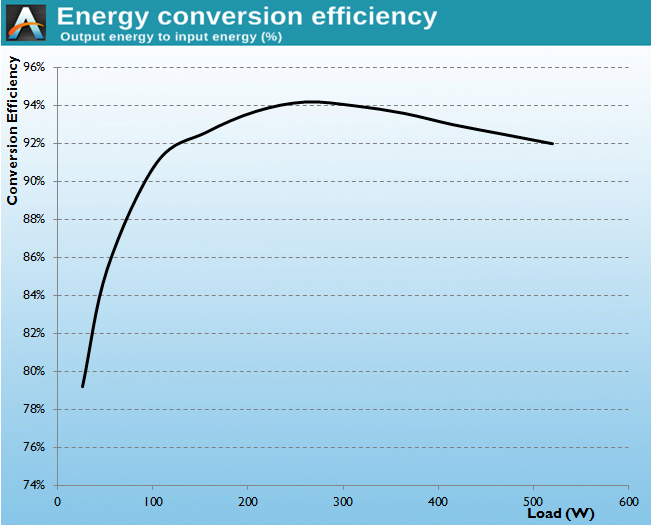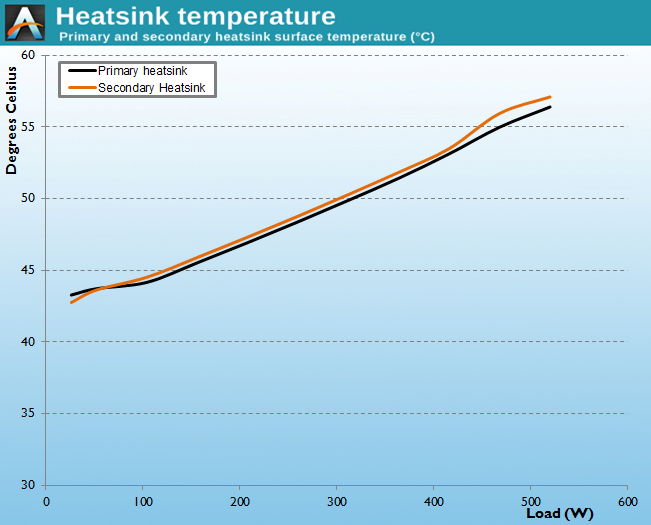SilverStone NightJar NJ520 Power Supply Review
by E. Fylladitakis on July 8, 2014 6:00 AM EST- Posted in
- Cases/Cooling/PSUs
- Seasonic
- PSUs
- Fanless
- SilverStone
Cold Test Results
For the testing of PSUs, we are using high precision electronic loads with a maximum power draw of 2700 Watts, a Rigol DS5042M 40 MHz oscilloscope, an Extech 380803 power analyzer, two high precision UNI-T UT-325 digital thermometers, an Extech HD600 SPL meter, a self-designed hotbox and various other bits and parts. For a thorough explanation of our testing methodology and more details on our equipment, please refer to our How We Test PSUs - 2014 Pipeline post.
Since this power supply is fanless, we are going to have two fewer graphs in this review. The first one is the noise chart, as this product has no moving parts and thus does not generate any noise, and the second one is the air temperature chart, as this method cannot be accurately applied if there is no forced airflow.
The electrical performance of the Nightjar NJ520 is excellent, which was to be expected from a Seasonic design. At room temperature, the Nightjar NJ520 easily meets the 80Plus Platinum certification and displays an average energy conversion efficiency within the nominal load range (20% to 100%) of 93.0%. Loads lower than 50 Watts however have a significant impact on the efficiency, which drops below 80%. This does not affect the 80Plus certification, which takes into account only the 20% to 100% nominal capacity range.
Even though it is a very efficient model, the Nightjar NJ520 remains surprisingly cool for a passive power supply, with the temperature of the primary and secondary heatsinks reaching up to 56.4 °C and 57.0 °C respectively. Although these figures are relatively high for a 520 Watt model in room temperature, the Nightjar has no forced cooling and therefore it is perfectly natural for it to be warmer than typical units.













44 Comments
View All Comments
R3MF - Tuesday, July 8, 2014 - link
i have an 8 year old Nightjar 300 that is still going strong. good units.Chickenlicker - Tuesday, July 8, 2014 - link
Good choice of a name for this unit given it's excellent aural performance. It is really unfortunate this little nocturnal bird called as nightjar is also famously recognized by it's other name "goatsucker".Sabresiberian - Tuesday, July 8, 2014 - link
It's good to see Silverstone use Seasonic as an OEM, or at least use a Seasonic design with the level of component quality we usually expect from Seasonic.I have to wonder if this is a sign of a change in Silverstone with regards to how they make their entire lineup. In the past the only way you could tell who made one of their PSUs is if an article by a hardware testing site (such as this one) mentioned it, and they often used OEMs that didn't exactly have good reputations. After one of their high-end, expensive units failed on me, taking mainboard and CPU with it, I sent them an email suggesting that they would do themselves and their customers better if they used Seasonic or Enermax or the like as a source; they really needed to pay attention to PSU reviews and see which OEMs got the respect from the community.
Hopefully they listened to me enough to change their entire policy. :)
That being said, while I don't really have a problem with the price for a design of this quality, a 3-year warranty is not a good thing, in my opinion (should it turn out that this unit doesn't have a longer warranty). 5 years is the minimum I will consider - and we now have units warrantied for 7 and 10 years on the market. I know warranty lengths are in part marketing points and not necessarily a sign of better quality, but I also think that if the company thinks it will be cost-effective to allow marketing to sell the units with a longer warranty it can only be a good sign in the end.
My experience with the failed Silverstone is the real-life reason I always, always tell people to buy a PSU about which they have read at least one review with strong positive results. If I had done that, I wouldn't have purchased the Silverstone unit I did, I trusted the name of the company selling the product too much. Even if it says "Seasonic" or "Enermax" or "Super Flower" on it, don't go by name brand alone. Anandtech, [Hard|OCP, jonnyGURU, Tomshardware, and a bunch of others can save you some potential grief.
Anyway, good on Silverstone for making a true high-end PSU that people can really trust, at least in this case.
Samus - Tuesday, July 8, 2014 - link
I don't see Silverstone putting their name on shit. We're not talking about Antec or Corsair here, companies that have to cater to all markets. Silverstone doesn't really have a "low-end" segment.frewster - Tuesday, July 8, 2014 - link
Not true. I have a dead Silverstone PSU from two or three years ago that had crap caps. Trusted Silverstone to make good stuff, even for their lower end, but it died shortly after its warranty ran out.Samus - Wednesday, July 9, 2014 - link
Interesting...was it a Seasonic design or FSP (mostly for SFX?) Those are the only two OEM's I know of that Silverstone rebrands, although some Googling revealed Enhance may have been an OEM at one point, and I never thought much of them.Still nobody tops PC Power & Cooling Silencer's (based on a tweaked Seasonic platform) at least up until 2010 when OCZ started destroying PCP&C.
Sabresiberian - Wednesday, July 9, 2014 - link
Tomshardware did an analysis of the companies that used OEMs a while back, and Silverstone was all over the map. What I said is a fact: Silverstone has used poor quality manufacturers to make some of their PSUs in the past.DarkSpatter - Tuesday, July 8, 2014 - link
I don't really see the point of fanless PSUs. Manufacturers always state that they still require some airflow in order to operate, so you can't expect to rid your system of fans completely. Furthermore, there are plenty of 'hybrid' PSUs on the market, which are silent up until they reach a certain temperature anyway. With the right choice of unit, you can have a silent PSU, together with the peace of mind that should it get overly hot, the active cooling will kick-in. And it'll cost less, too :)Death666Angel - Tuesday, July 8, 2014 - link
I like the peace of mind that a hybrid solution provides as well. I have a Superflower 500W PSU with platinum certification that is fanless until 40% load I think. That is quiet enough for me during normal use (I have a quiet case fan and 4 quiet fans for my radiator) and when I game I have my headphones on.mapesdhs - Tuesday, July 8, 2014 - link
The point of fanless PSUs is they don't make any noise. Self-evident perhaps,
but you did say. :D I recently built a new gateway/firewall box which I wanted
to be as quiet as possible, for which I bought a new SIlverstone case:
http://www.silverstonetek.com/product.php?pid=303
and a new Seasonic Platinum SS-400FL2 400W fanless PSU (eBay item
131209207247). All the other items were obtained via normal eBay auctions.
The case does have two fans: a built-in 180mm which is set to run at a very
low speed, and a rear Thermalright 120mm 600rpm 'ultra silent' model. The
case is completely inaudible.
I read _a lot_ of reviews about Hybrid PSUs, especially on sites where the
PSUs are examined inside for build quality, etc. My conclusion from reading
reviews is that hybrid PSUs below 700W are rubbish. In many cases the
poor build quality, especially the soldering, really is shocking (to coin a phrase).
Peace of mind? Not really, not with the bits of junk that many companies are
stuffing into low wattage hybrid units atm. A good quality fanless like the Seasonic
or Nightjar version is a much better choice. The unit I bought cost a fair bit more
than a hybrid, but I couldn't get away from being suspcious that such hybrid models
are typically only around 35 to 55 UKP; they're cheap for a reason. The other comment
I found on reviews again and again was that the included fan was too loud. Models that
are marketed as silent/quiet/etc. simply aren't, not by any measure.
Btw, with the PSU facing as recommend, convection gives sufficient cooling anyway.
I'm sure my gateway unit would be fine without the two fans, but I wanted to be sure,
and they run at such a slow speed I cannot hear them. The mbd (Intel DQ77MK)
controls the fans, power saving features are all on, max fan speed is set to 50%, so
the RPMs are really low. CPU is just a Pentium G2020 I.B., one 4GB DIMM, 120GB SSD,
and that's it. See:
http://www.sgidepot.co.uk/misc/gatewaypc1.jpg
http://www.sgidepot.co.uk/misc/gatewaypc2.jpg
http://www.sgidepot.co.uk/misc/gatewaypc3.jpg
Note the DVDRW in the case is not connected to any power cable (I'm going ro rig up
a switch mounted in the upper bay so that I can provide power to the DVDRW if needed).
For this type of application, a quality fanless PSU is perfect, and the cost saving of most
hybrids isn't worth the much higher risk. One is hardly saving anything if the PSU dies,
damaging other parts in the process.
In reviews I read of hybrids, authors found instances of loose solder lumps falling out
of the units, totally botched reworking on the PCB, shoddy initial solder work, etc.
You get what you pay for in this market. I was initially hesitant to pay so much
for a PSU, but I'm glad I did.
Ian.